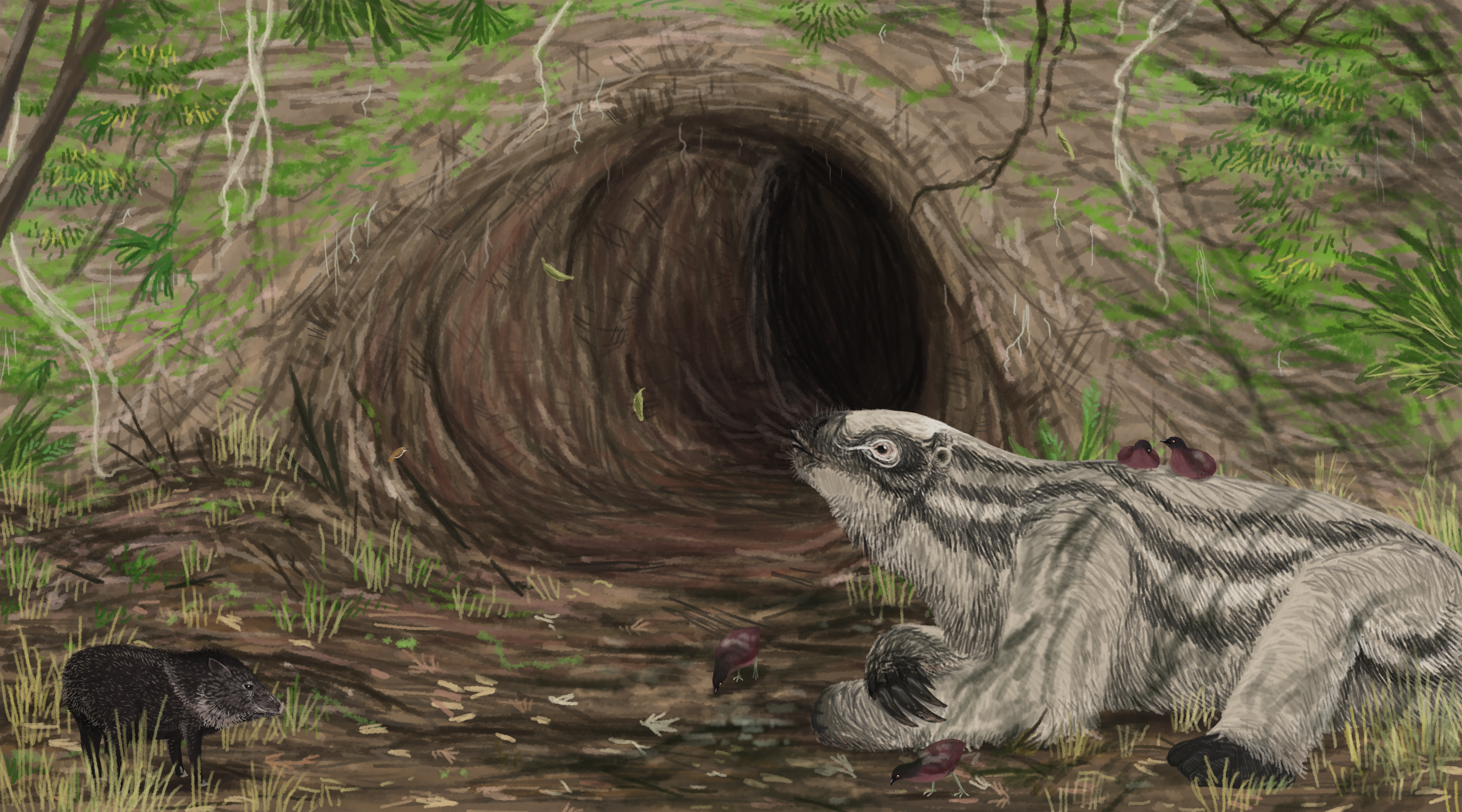HOME | DD
 TrollMans — Resting for a while after the strenuous work
TrollMans — Resting for a while after the strenuous work

Published: 2019-02-17 06:46:40 +0000 UTC; Views: 20166; Favourites: 373; Downloads: 33
Redirect to original
Description
Ground sloth proudly presents his latest masterpiece, "Big Hole".Peccary doesn't understand modern art.
---
Late Pleistocene (0.012 MYA), São Paulo
Lestodon armatus (armoured robber tooth)- a species of mylodontid known from the Pleistocene of South America, it was one of the largest species of the numerous ground sloths which roamed the continent during much of the Cenozoic, reaching over four metres in length and 2.5 tonnes in weight. A broad, flattened snout indicates it was probably a bulk feeder, consuming a wide range of primarily low-growing vegetation in large quantities, although probably able to rear up to browse from trees. The species is the largest of the ground sloths to show adaptations for digging, and wear patterns on teeth correlate that it likely dug for roots and tubers in the grainy soil. It is also one of the xenathran species suspected of creating the gigantic burrows, many of which still survive to this day and were used as shelter by ancient humans even long after the extinction of their creators (which they may also have caused). The exact purpose of these burrows is uncertain, especially considering they are enormous even taking into account the size of their creators, but they may have been used as shelter during the drier and more arid period of the ice ages (many of these paleoburrows are now unusable because they are flooded). Some specimens are found with large, broad tusks, which may represent sexual dimorphism.
Pecari tajacu (peccary peccary)- a species of tayassuid known from the Late Quaternary of South America, Central America, and the southern United States. It is a widespread ungulate species that often lives in highly numerous herds, with a diverse diet that allows them to easily adapt to a range of habitats and available foodstuffs. They reach between 50-60 centimetres in shoulder height and around 20 kilograms in weight as adults. They are primarily diurnal in most areas and rest in burrows, under boulders, or within caves together when sleeping. As they have trouble staying cool, they tend to associate around bodies of water like ponds and forage in the early day and late afternoon when it is cooler. Their primary predators (besides humans) are large cats such as cougars and jaguars, although they have been known to use their numbers to mob predators, attacking with their sharp tusks. A large scent gland on their rump is used to mark their territory and one another, which gives them an unpleasant scent.
Crypturellus obsoletus (common/old/ordinary small hidden tail)- a species of tinamiform known from the Quaternary of South America (no reported fossils), and like most species of the clade, it is a small ground-dwelling bird. It is a recluse forest animal reaching roughly a foot in total length and 450 grams that forages singly or in small groups in the undergrowth for seeds, small fruit, and insects. Because of its secretive nature, its behaviour is poorly studied, although it is believed that sexual reproduction is similar to other tinamous, with males taking most of the brooding and care of chicks. Eggs are reported to come in a glazed bright pink or chocolate brown in colour and laid in nests among tree roots.
Troglodytes aedon (Aedon hole dweller)- a species of passerine known from the Late Pleistocene to Holocene of the Americas, and is one of the most widely distributed bird species in the western hemisphere (although it migrates south from its northern range in winter) and found in most terrestrial habitats. Its brownish coloured plumage and birdsong varies slightly based on its geographical region and represent several distinct subspecies and populations. Like most wrens, it is a small (roughly twelve centimetres long, and 10-12 grams) primarily insectivorous although also preying on other small invertebrates like spiders and snails. They are monogamous cavity nesters, constructing nests out of small sticks and other materials; aggressively territorial despite their small size, they will often destroy the eggs of nearby birds or fill their nests with sticks to render them unusable. The female alone broods the eggs, while both parents will feed and care for the chicks, which are fed almost continuously.
---
Graphic design is my passion.
Related content
Comments: 16

👍: 1 ⏩: 0

👍: 1 ⏩: 0

The coloration of the Lestodon reminds me of a spink (from "The Future is Wild").
👍: 0 ⏩: 0

i could tell that this beast was very important to troglofauna
👍: 0 ⏩: 0

By the way, please pardon my Delusions of Humour Troll Mans - my own review for this piece of art is "First Rate" and could hardly be otherwise, given the quality of this piece and the high standard of all your other works.
👍: 0 ⏩: 0

"A mature work, bold yet classic with a decidedly earthy finish - 9/10 would recommend" - THE HOLE DEAL.
"I came for the exhibition, I stayed for the bird-bath" - GROUND & SKY.
"I did my best to join in, but just couldn't bring myself to pig out" - WHOLE HOG.
👍: 0 ⏩: 0

Love the reference to that shitpost chart of a ground sloth digging a hole
👍: 0 ⏩: 1

That crappy-looking diagram was really the only reason I drew this.
👍: 0 ⏩: 1

I mean it’s probably accurate, but man it just radiates shitposting energy
Awesome art as always btw
👍: 0 ⏩: 1

This one
goo.gl/images/HJvv3S
👍: 0 ⏩: 0

Pretty cool and already being reminded about History of the World, Part 1.
👍: 0 ⏩: 0

Oh wow, such an amazing composition! Never heard of such a huge animal being a burrower, that's crazy!
👍: 0 ⏩: 0





























